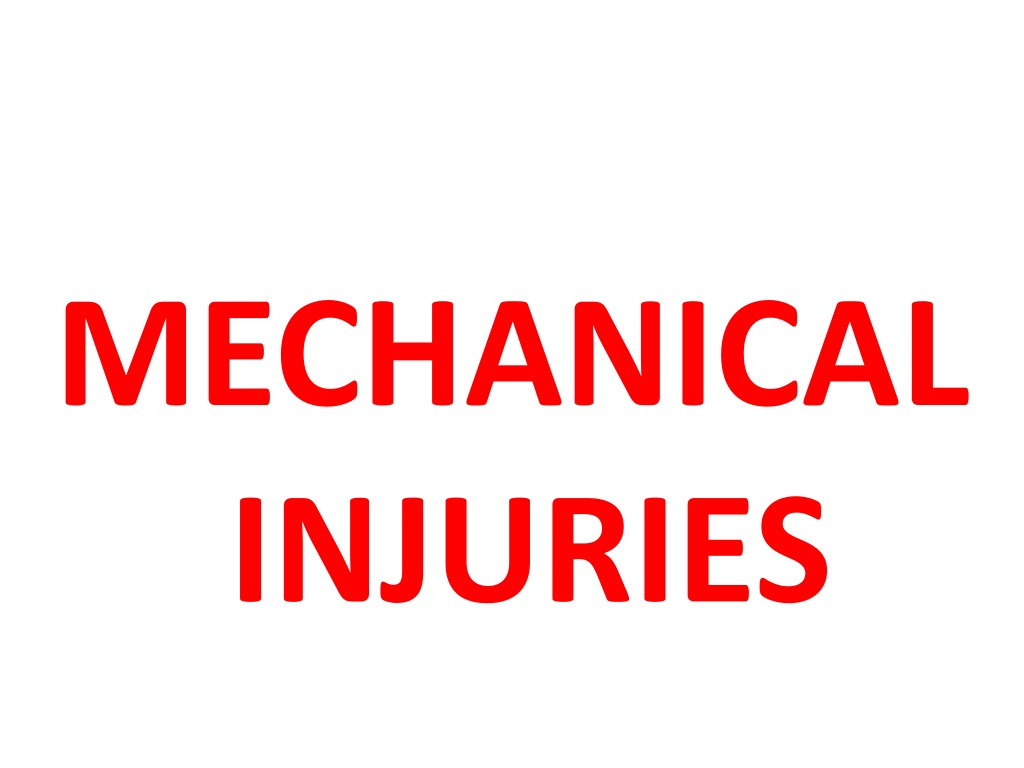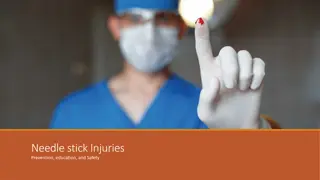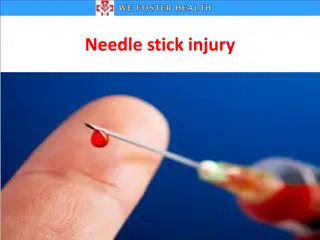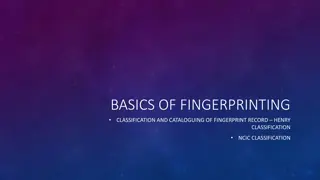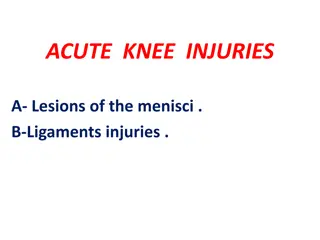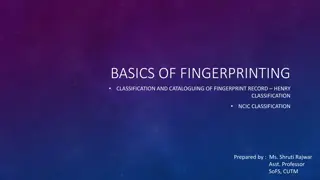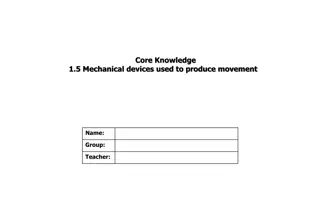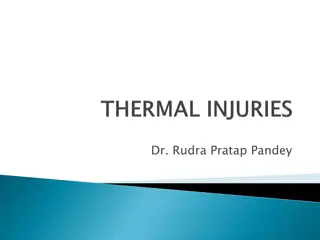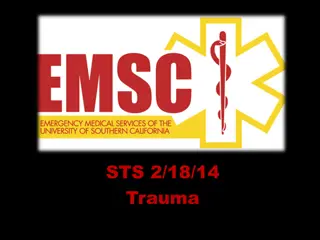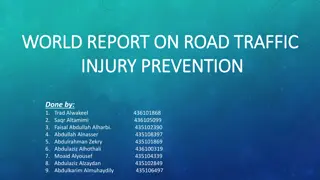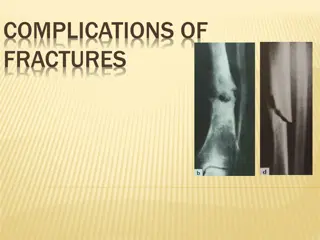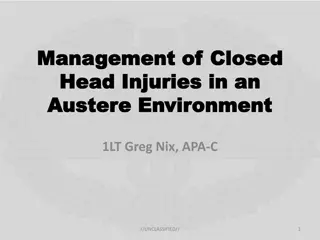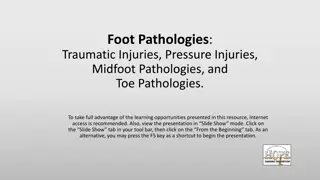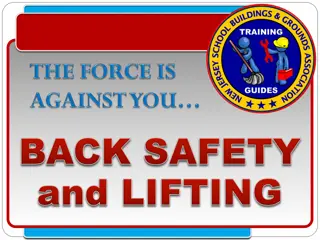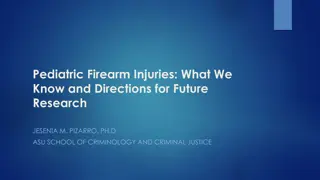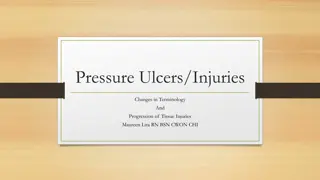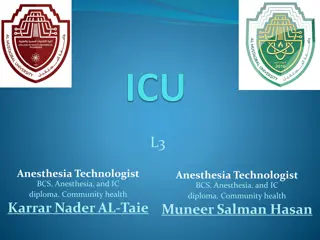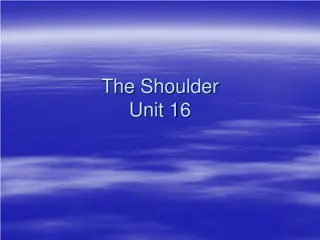Mechanical Injuries: Types, Classification, and General Principles
Mechanical injuries encompass a variety of harms caused to the body, mind, reputation, or property. These injuries can be classified into medical, legal, and medico-legal categories based on factors like intentionality. The types of mechanical injuries range from blunt force trauma to thermal, chemical, and physical injuries. Understanding the principles behind mechanical injuries involves considering factors like energy transfer, tissue characteristics, and impact dynamics.
Uploaded on Sep 14, 2024 | 0 Views
Download Presentation

Please find below an Image/Link to download the presentation.
The content on the website is provided AS IS for your information and personal use only. It may not be sold, licensed, or shared on other websites without obtaining consent from the author. Download presentation by click this link. If you encounter any issues during the download, it is possible that the publisher has removed the file from their server.
E N D
Presentation Transcript
MECHANICAL INJURIES
MECHANICAL INJURIES Injury (44 IPC) Injury is any harm ,whatever illegally caused to any person in body, mind, reputation or property. Medically a wound or injury is a break of the natural continuity of any of the tissue of the living body.
Classification 1) Medical 2) Legal - Simple & Grievous 3) Medico legal - Suicidal Defence Homicidal Accidental Fabricated Self inflicted
MEDICAL I. Mechanical A. Due to blunt force - 1. Abrasion 2. Contusion 3. Laceration 4. Fracture & dislocation B. Due to sharp force - Incision Chop wound Stab wound C. Firearms - Firearm wound Blast injuries
II. Thermal injuries 1. Due to cold: a) Frostbite b) Trench foot 2. Due to heat: a) Burns c) Immersion foot b) Scalds
III. Chemical injuries- a) Corrosive acids b) Corrosive alkalis V. Physical injuries - Electricity Lightening Radiation Radioactive substances V. Explosions
General Principles The wound is caused by the mechanical force of : either the movement of body itself (counterforce is rigidity of stationary object) or a movingweapon (counter force is inertia of body) A combination of these two events is seen in most cases. Impact between force and counter force (transfer of energy)
Tissues vary in their solidity, fluidity, density and elasticity. Energy is spent in - moving of body - compression or traction - displacement & deformation - elongation of tissues - bending, torsion or shearing. Shearstrain - is parallel to plane of contact - rupture occurs when cohesiveness is exceeded
Factors affecting Mechanical Injuries: 1. Amount of energy discharged K.E. = mv It means velocity has more influence as compared to mass of the object 2. Time Shorter the time period required to transfer the energy, greater the likelihood of the damage 3. Area of transfer Smaller the area, greater the damage
4. Elasticity and plasticity The less elastic and plastic the tissue, the greater the damage 5. Inertia of tissue 6. Hydrostatic pressure A force, transmitted through a fluid containing tissues, such as stomach and bladder, will force the fluid away from the area of contact, in damage.
Definition Abrasion is destruction of the skin, which usually involves the superficial layers of the epidermis only. They heal without scar formation
Types 1. Scratches 2. Grazes 3. Pressure abrasion 4. Impact abrasion Patterned abrasion
Scratches : Ascratch is linear abrasion with length but no significant width, or a very superficial incision, depending on the agent. Point scratch : Produced by the sharp or pointed object not sharp enough to incise, but pointed enough to scratch such as fingernails, pin, thorn, etc .
Graze Sliding ,scraping , or grinding abrasions. They are the most common types They occur when there is movement between the skin and some rough surface in contact with it. They show uneven, parallel lines with the epithelium heaped up at the ends of these lines, which indicate the direction of applied force. Brush abrasion or gravel rash : It is produced by the violent lateral force against a surface as in dragging over the ground.
Friction burn (Scuff or Brush abrasion) It is an extensive, superficial, reddened excoriated area without bleeding and without any linear mark. It may occur due to tangential force with a smooth surface or when the skin is covered with clothing. It is seen in motor cyclists, pedestrians, persons ejected from the vehicles etc.
Pressure abrasions (Crushing or Friction abrasions) They are caused by crushing of the superficial layers of the epidermis and are associated with bruise of the surrounded area. If force is applied at an angle of 90 , then pressure abrasion is produced. e.g. Ligature mark in hanging and strangulation and teeth marks
Impact abrasion (Contact or Imprint Caused by impact with a rough object , when the force is applied at or near a rightangle to the skin surface . The abrasion is slightly depressed below the surface, unless there is local oedema or there is bulging due to underlying contusion e.g. When a person is knocked down by a car, the pattern of the radiator grille, a headlamp rim, or the tread of tyre abrasion)
Patterned abrasions Impact abrasion and Pressure abrasion reproduce the pattern of the object causing it and are called patterned abrasions. Patterned is an injury that suggests an inflicting instrument or unique means of its causation. Produced when the force is applied at right angle to the surface of skin. It is associated with intradermal bruise due to capillaries damage. e.g. -When motor tyre passes over the skin -Imprint of bicycle chain -Spiral electric wires, rope, serrated knife,etc.
Age of the abrasion : Abrasion heals from periphery to centre. Age can be determined by colour change and by histologically Fresh Bright red 12-24 hrs- lymph and blood dries up leaving a bright red scab 2-3 days- reddish brown scab 4-7 days- dark brown to brownish black scab -Epitheliumgrows & covers the defect After 7 days- scab dries, and falls off leaving depigmented area below.
Histology Perivascular cellular infiltration seen at 4-6 hours At 12 hours threelayers are seen: - Surface zone of fibrin and redcells - A deeper zone of infiltrating polymorphs - A deepest zone of collagen At 48 hours: scab is well formed and epithelial regeneration is seen at the margin of the scab 4-5 days -small abrasion are completely covered by 5-8 days -sub epithelial granulationtissue is formed Reticulum fibres are formed at 8 days Collagen fibres are formed at 9-12 days Regression begins at 12 days epithelium
Differences between Ante-mortem and Post-mortem abrasions Ante-mortem abrasions Post-mortem abrasions Traits 1. Site Anywhere on the body Usually over the bony prominences 2. Colour Bright reddish brown Yellowish, translucent and parchment like 3. Exudation More ; scab slightly raised Less ; scab often lies slightly below the level of skin 4. Microscopy Intravital reaction and congestion seen No intravital reaction and no congestion
Circumstances of injuries: Usually seen in accidents and assaults Rare in suicide Sometimes hysterical abrasion over accessible areas to fabricate the false charge of assault Abrasion on the face or body of assailant indicate the struggle Person collapsing due to heart attack may fall forward and shows abrasion on the front part of the body The alcoholic person may fall backwards and abrasions will be seen on occiput. women may produce
Medico legal importance Gives idea about the site of impact and direction of force. Only external sign of severe internal injury. Patterned abrasion can identify the weapon causing it. Age of injury can be determined by colour changes Scene of crime can be determined by the presence of dirt, dust, grease etc.
Distribution of injuries show the Character and manner of injury :- In throttling: crescentic abrasion are seen on neck In smothering: abrasion are seen on mouth and nostril In rape: abrasion are seen on the breasts, genitals, inner side of thigh, and around the anus Sign of struggle: abrasion on face of the assailant
Differential diagnosis: Erosions of the skin produced by the ants Excoriations of the skin by excreta Pressure sores Drying of the skin.
CONTUSION Definition: A contusion is an effusion of blood into the tissues, due to the rupture of blood vessel, caused by blunt trauma.
Contusion is present in skin and internal organs . Most contusion are present in the subcutaneous tissues above the deep fascia. In contusion, there is painful swelling and rearing of subcutaneous tissues destruction of skin. usually without the
A bruise is lighter in colour in centre because extravasated blood is pushed outward by the impact. Size of bruise is slightly largerthan the surface of the agent which caused it as the blood continues to escape into the area.
Factors modifying size and shape of bruise 1. Condition and type of tissue In vascular and loose parts such as face, vulva, scrotum, large bruise are produced by small impact. In boxers and athletes, bruising is much less because of good muscle tone.
2. Age -Children bruise more easily because of softer tissues and delicate skin. - Old person easily because of loss of flesh and cardiovascular changes. 3. Sex Women bruise more easily than man because of more subcutaneous fat and more delicate tissues.
